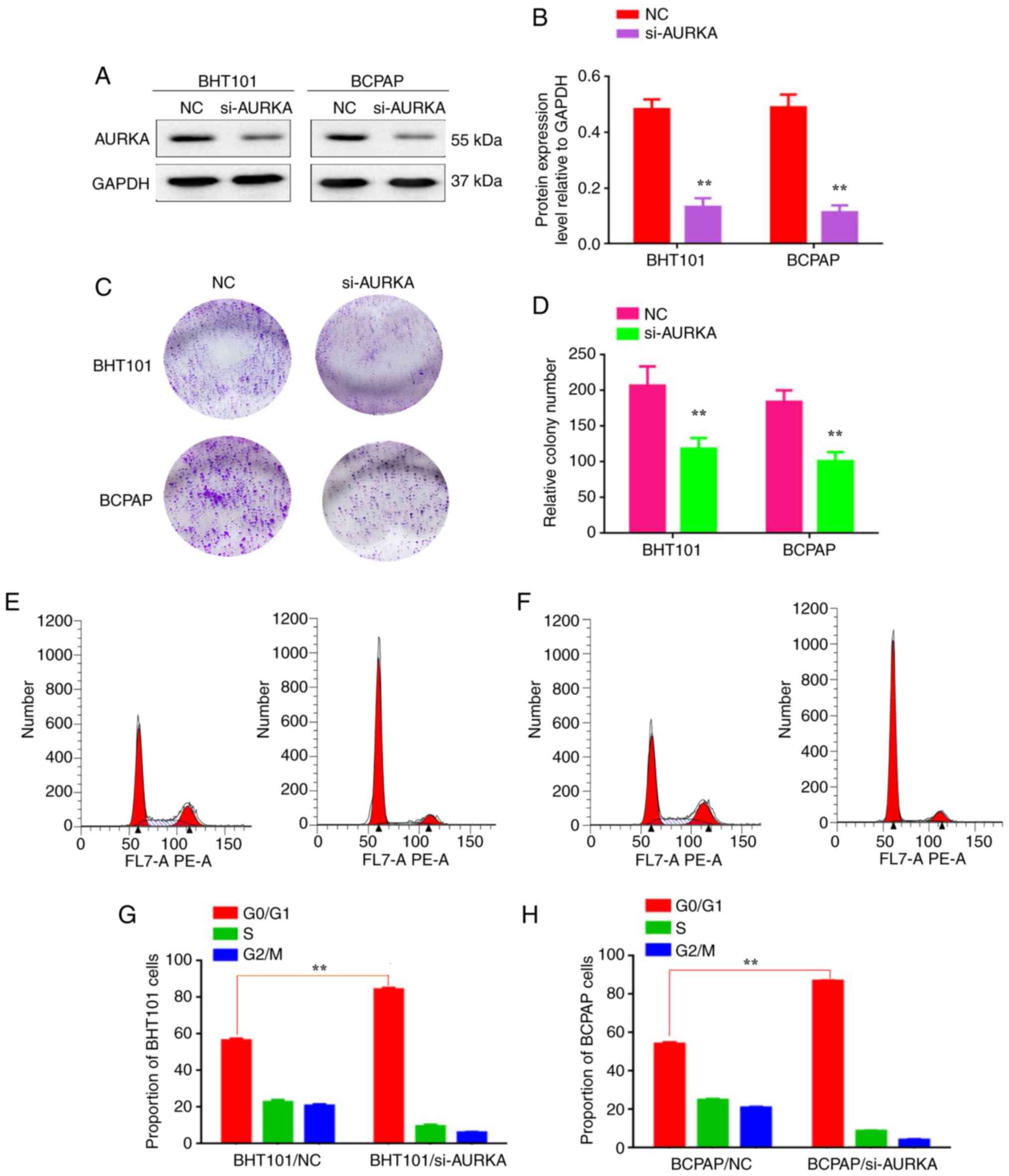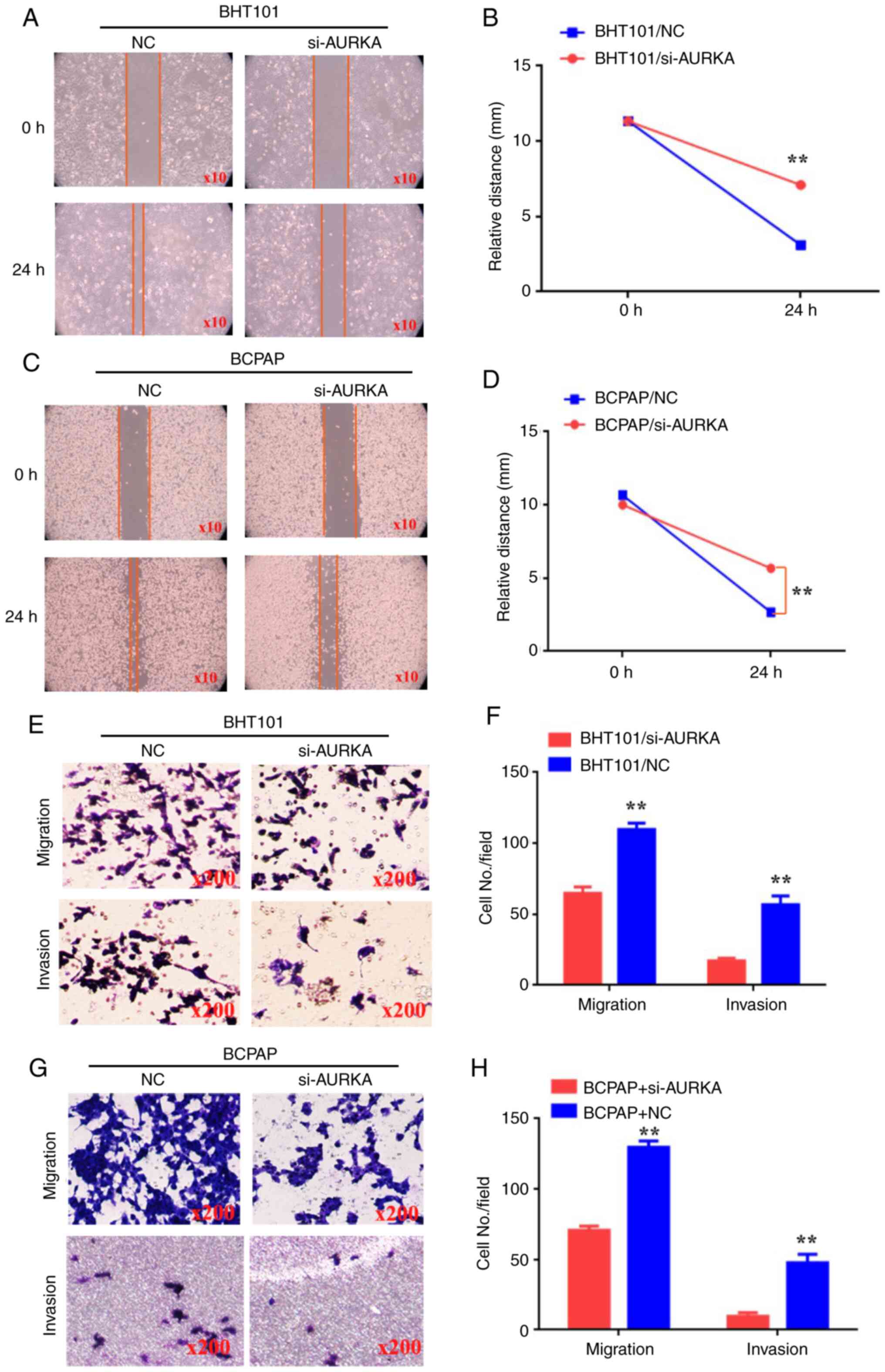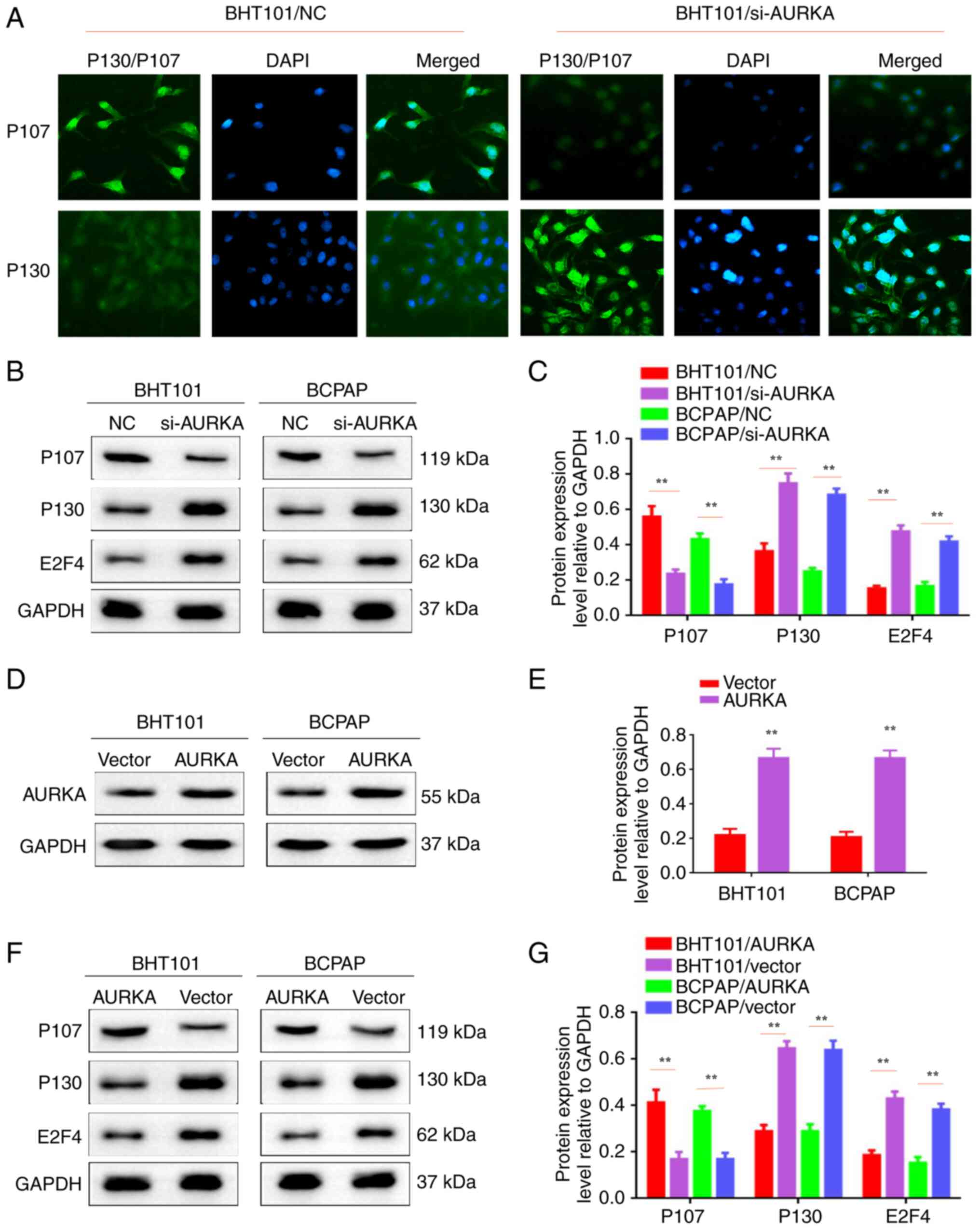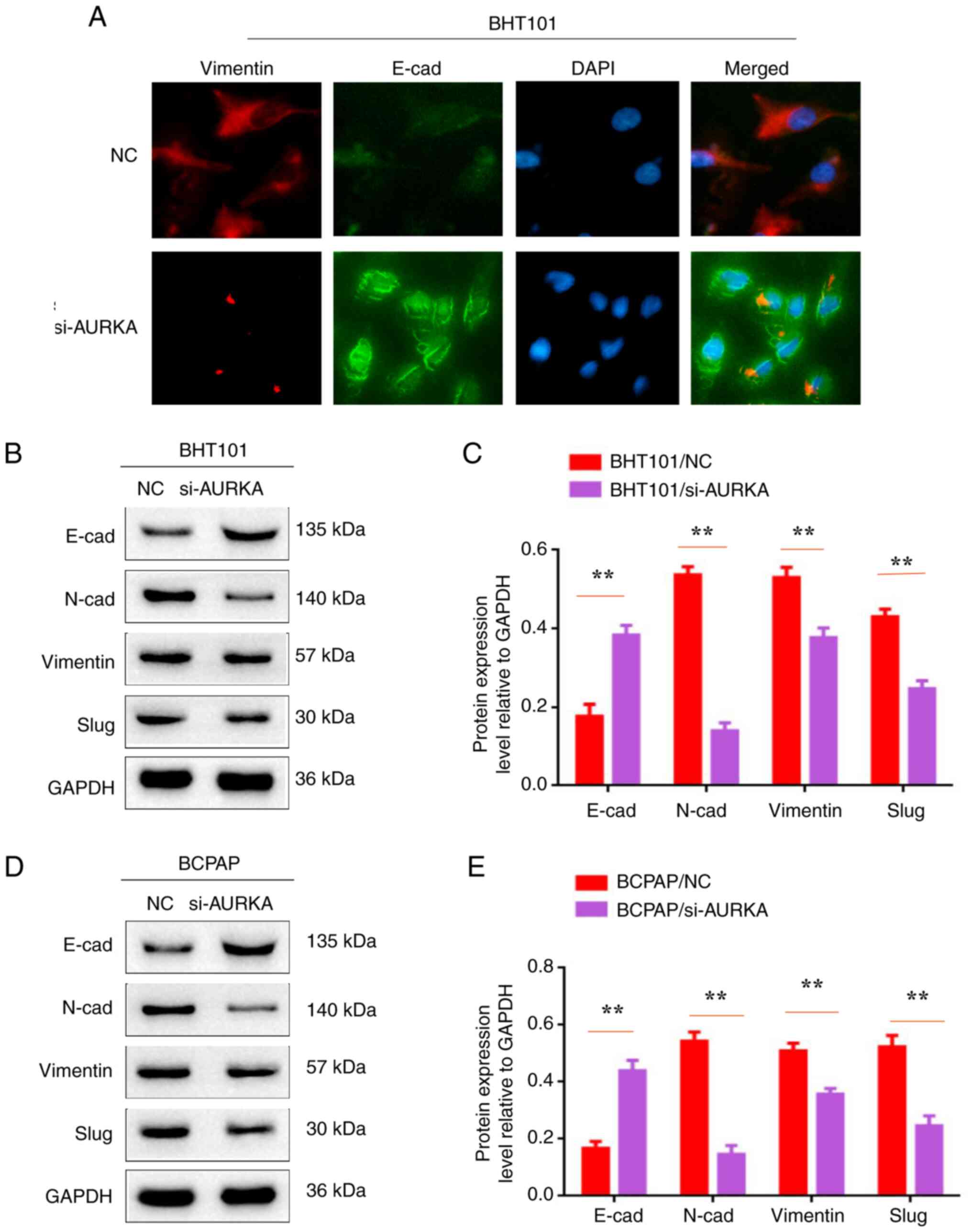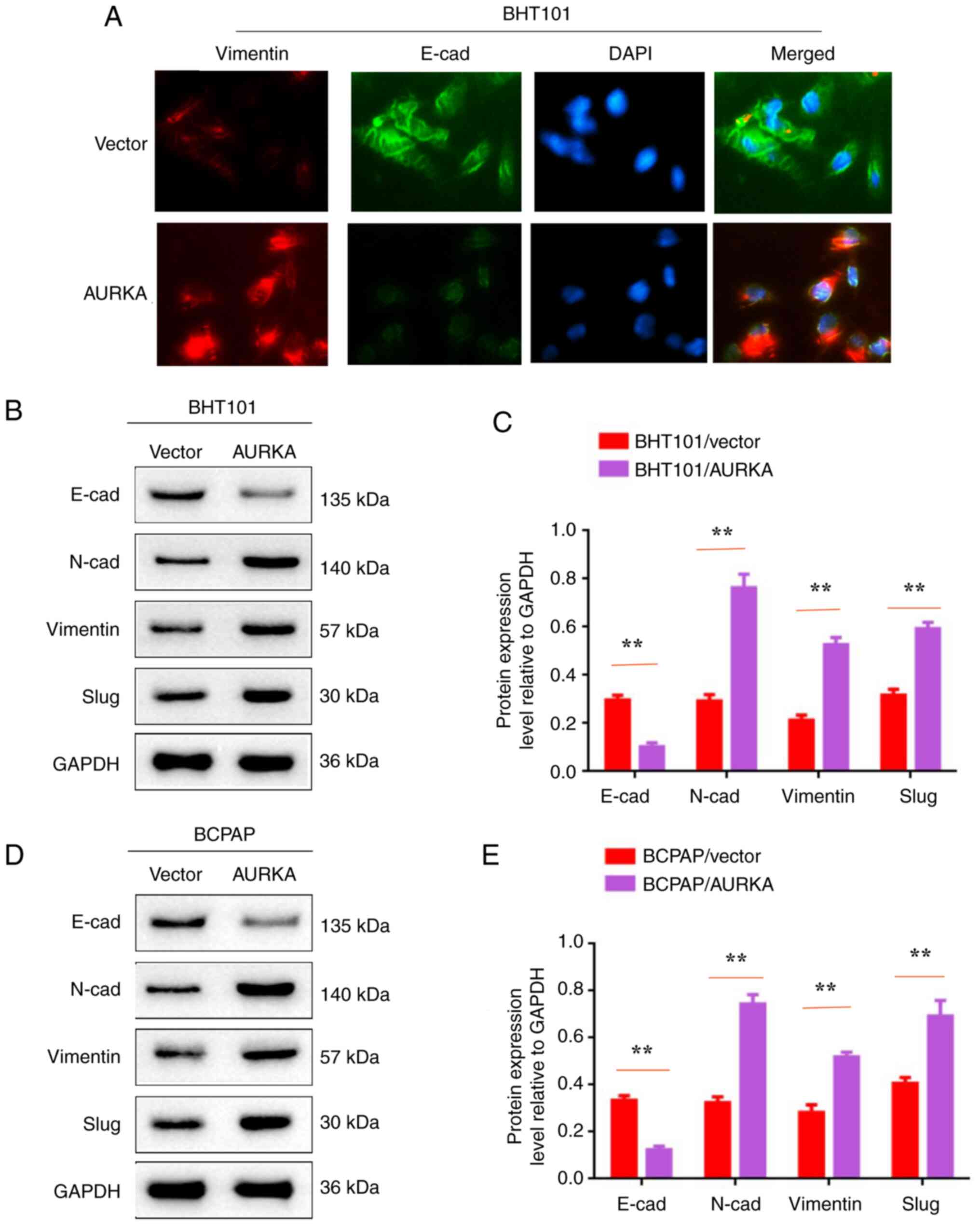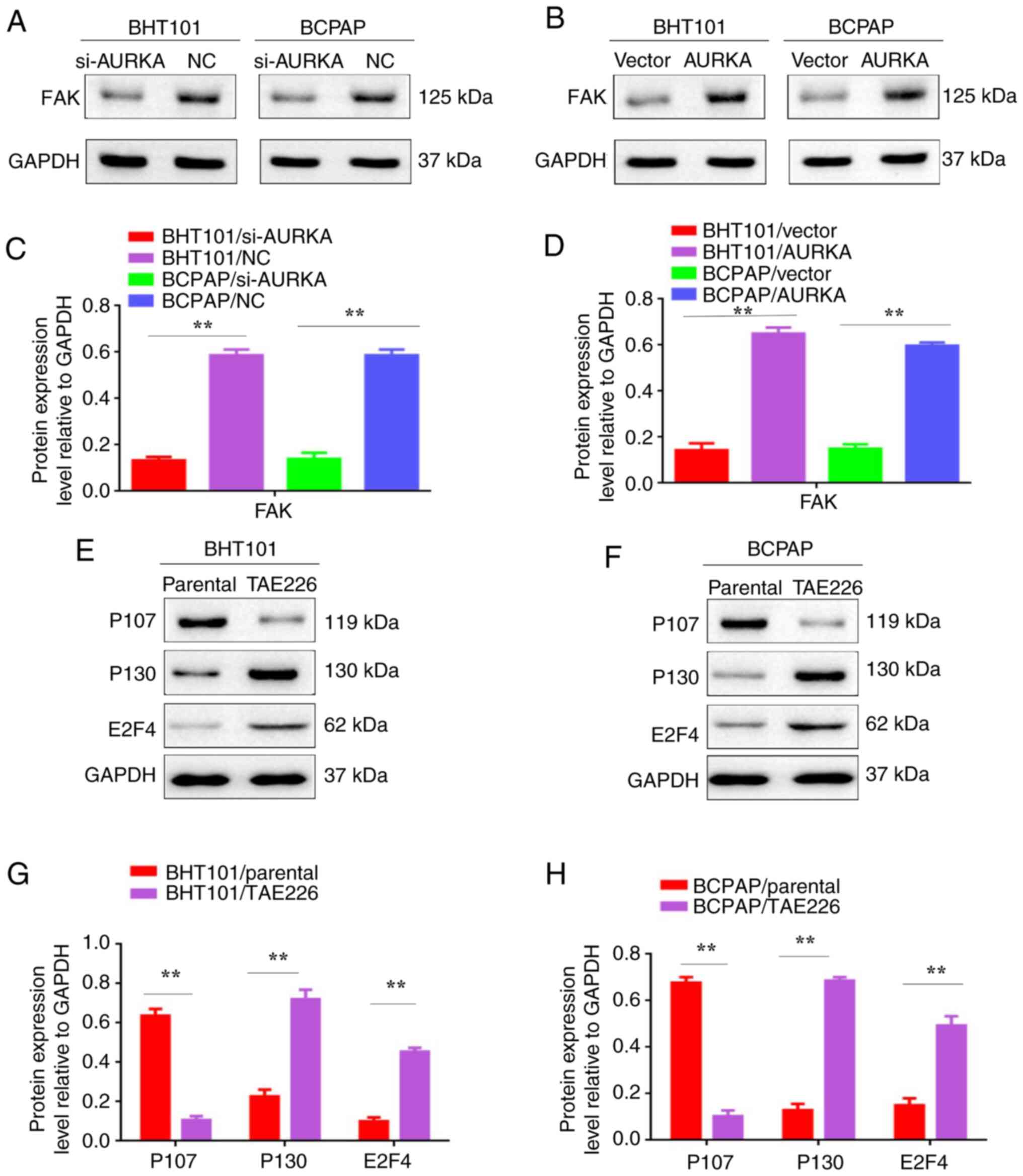|
1
|
Liao Y, Hua Y, Li Y, Zhang C, Yu W, Guo P,
Zou K, Li W, Sun Y, Wang R, et al: CRSP8 promotes thyroid cancer
progression by antagonizing IKKα-induced cell differentiation. Cell
Death Differ. 28:1347–1363. 2021.PubMed/NCBI View Article : Google Scholar
|
|
2
|
Xu S, Mo S, Lin J, Yan Y, Liu X, Wu K,
Zhang H, Zhu Y, Chen L and Chen X: Loss of ID3 drives papillary
thyroid cancer metastasis by targeting E47-mediated epithelial to
mesenchymal transition. Cell Death Discov. 7(226)2021.PubMed/NCBI View Article : Google Scholar
|
|
3
|
Zhan S, Wang T and Li J, Zhu H, Ge W and
Li J: Asporin interacts with HER2 to promote thyroid cancer
metastasis via the MAPK/EMT signaling pathway. Front Oncol.
12(762180)2022.PubMed/NCBI View Article : Google Scholar
|
|
4
|
Asteriti IA, Polverino F, Stagni V,
Sterbini V, Ascanelli C, Naso FD, Mastrangelo A, Rosa A, Paiardini
A, Lindon C and Guarguaglini G: AurkA nuclear localization is
promoted by TPX2 and counteracted by protein degradation. Life Sci
Alliance. 6(e202201726)2023.PubMed/NCBI View Article : Google Scholar
|
|
5
|
Maimaiti Y, Jie T, Jing Z, Changwen W, Pan
Y, Chen C and Tao H: Aurora kinase A induces papillary thyroid
cancer lymph node metastasis by promoting cofilin-1 activity.
Biochem Biophys Res Commun. 473:212–218. 2016.PubMed/NCBI View Article : Google Scholar
|
|
6
|
Yang LY, He CY, Chen XH, Su LP, Liu BY and
Zhang H: Aurora kinase A revives dormant laryngeal squamous cell
carcinoma cells via FAK/PI3K/Akt pathway activation. Oncotarget.
7:48346–48359. 2016.PubMed/NCBI View Article : Google Scholar
|
|
7
|
Ban Y, Zou Y, Liu Y, Lee SB, Bednarczyk
RB, Sheng J, Cao Y, Wong STC and Gao D: Targeting ribosome
biogenesis as a novel therapeutic approach to overcome EMT-related
chemoresistance in breast cancer bioRxiv. Preprint.
28(546927)2023.PubMed/NCBI View Article : Google Scholar
|
|
8
|
Zhang Z, Li Y, Fan L, Wang B, Liu W, Cui J
and Tan B: LncRNA THUMPD3-AS1 promotes invasion and EMT in gastric
cancer by regulating the miR-1297/BCAT1 pathway. iScience.
26(108012)2023.PubMed/NCBI View Article : Google Scholar
|
|
9
|
Meng F, Hua S, Chen X, Meng N and Lan T:
Lymph node metastasis related gene BICC1 promotes tumor progression
by promoting EMT and immune infiltration in pancreatic cancer. BMC
Med Genomics. 16(263)2023.PubMed/NCBI View Article : Google Scholar
|
|
10
|
Koyama Y, Fujihara S, Chiyo T, Matsui T,
Hamaya S, Fujita K, Tani J, Morishita A, Kobara H, Ono M, et al:
Role of Mir-452-5p overexpression in epithelial-mesenchymal
transition (EMT) in early-stage colorectal cancer. In Vivo.
37:1980–1990. 2023.PubMed/NCBI View Article : Google Scholar
|
|
11
|
Li M, Sun C, Bu X, Que Y, Zhang L, Zhang
Y, Zhang L, Lu S, Huang J, Zhu J, et al: ISL1 promoted
tumorigenesis and EMT via Aurora kinase A-induced activation of
PI3K/AKT signaling pathway in neuroblastoma. Cell Death Dis.
12(620)2021.PubMed/NCBI View Article : Google Scholar
|
|
12
|
Miro C, Di Cicco E, Ambrosio R, Mancino G,
Di Girolamo D, Cicatiello AG, Sagliocchi S, Nappi A, De Stefano MA,
Luongo C, et al: Thyroid hormone induces progression and
invasiveness of squamous cell carcinomas by promoting a
ZEB-1/E-cadherin switch. Nat Commun. 10(5410)2019.PubMed/NCBI View Article : Google Scholar
|
|
13
|
Jiang W, Cai F, Xu H, Lu Y, Chen J, Liu J,
Cao N, Zhang X, Chen X, Huang Q, et al: Extracellular signal
regulated kinase 5 promotes cell migration, invasion and lung
metastasis in a FAK-dependent manner. Protein Cell. 11:825–845.
2020.PubMed/NCBI View Article : Google Scholar
|
|
14
|
Li H, Fu X, Zhao J, Li C, Li L, Xia P, Guo
J, Wei W, Zeng R, Wu J, et al: EXOC4 promotes diffuse-type gastric
cancer metastasis via activating FAK signal. Mol Cancer Res.
20:1021–1034. 2022.PubMed/NCBI View Article : Google Scholar
|
|
15
|
He X, Wang L, Li H, Liu Y, Tong C, Xie C,
Yan X, Luo D and Xiong X: CSF2 upregulates CXCL3 expression in
adipocytes to promote metastasis of breast cancer via the FAK
signaling pathway. J Mol Cell Biol. 15(mjad025)2023.PubMed/NCBI View Article : Google Scholar
|
|
16
|
Liu P, Sun Y, Liu S, Niu J, Liu X and Chu
Q: SY-707, an ALK/FAK/IGF1R inhibitor, suppresses growth and
metastasis of breast cancer cells. Acta Biochim Biophys Sin
(Shanghai). 54:252–260. 2022.PubMed/NCBI View Article : Google Scholar
|
|
17
|
Ghosh S and Cho SJ: Three-dimensional-QSAR
and relative binding affinity estimation of focal adhesion kinase
inhibitors. Molecules. 28(1464)2023.PubMed/NCBI View Article : Google Scholar
|
|
18
|
Xiao Y, Tu Y and Li Y: Expression level of
long non-coding RNA colon adenocarcinoma hypermethylated serves as
a novel prognostic biomarker in patients with thyroid carcinoma.
Biosci Rep. 41(20210284)2021.PubMed/NCBI View Article : Google Scholar
|
|
19
|
Zhang H, Chen X, Jin Y, Liu B and Zhou L:
Overexpression of Aurora-A promotes laryngeal cancer progression by
enhancing invasive ability and chromosomal instability. Eur Arch
Otorhinolaryngol. 269:607–614. 2012.PubMed/NCBI View Article : Google Scholar
|
|
20
|
Zhang H, Chen X, Liu B and Zhou L: Effects
of stable knockdown of Aurora kinase A on proliferation, migration,
chromosomal instability, and expression of focal adhesion kinase
and matrix metalloproteinase-2 in HEp-2 cells. Mol Cell Biochem.
357:95–106. 2011.PubMed/NCBI View Article : Google Scholar
|
|
21
|
Niu NK, Wang ZL, Pan ST, Ding HQ, Au GH,
He ZX, Zhou ZW, Xiao G, Yang YX, Zhang X, et al: Pro-apoptotic and
pro-autophagic effects of the Aurora kinase A inhibitor alisertib
(MLN8237) on human osteosarcoma U-2 OS and MG-63 cells through the
activation of mitochondria-mediated pathway and inhibition of p38
MAPK/PI3K/Akt/mTOR signaling pathway. Drug Des Devel Ther.
9:1555–1584. 2015.PubMed/NCBI View Article : Google Scholar
|
|
22
|
Dar AA, Goff LW, Majid S, Berlin J and
El-Rifai W: Aurora kinase inhibitors - rising stars in cancer
therapeutics? Mol Cancer Ther. 9:268–278. 2010.PubMed/NCBI View Article : Google Scholar
|
|
23
|
Correa RJ, Peart T, Valdes YR, DiMattia GE
and Shepherd TG: Modulation of AKT activity is associated with
reversible dormancy in ascites-derived epithelial ovarian cancer
spheroids. Carcinogenesis. 33:49–58. 2012.PubMed/NCBI View Article : Google Scholar
|
|
24
|
Ruppender N, Larson S, Lakely B, Kollath
L, Brown L, Coleman I, Coleman R, Nguyen H, Nelson PS, Corey E, et
al: Cellular adhesion promotes prostate cancer cells escape from
dormancy. PLoS One. 10(130565)2015.PubMed/NCBI View Article : Google Scholar
|
|
25
|
Spiliotaki M, Mavroudis D, Kapranou K,
Markomanolaki H, Kallergi G, Koinis F, Kalbakis K, Georgoulias V
and Agelaki S: Evaluation of proliferation and apoptosis markers in
circulating tumor cells of women with early breast cancer who are
candidates for tumor dormancy. Breast Cancer Res.
16(485)2014.PubMed/NCBI View Article : Google Scholar
|
|
26
|
Iyirhiaro GO, Zhang Y, Estey C, O'Hare MJ,
Safarpour F, Parsanejad M, Wang S, Abdel-Messih E, Callaghan SM,
During MJ, et al: Regulation of ischemic neuronal death by
E2F4-p130 protein complexes. J Biol Chem. 289(18202)2014.PubMed/NCBI View Article : Google Scholar
|
|
27
|
Huang Y, Hong W and Wei X: The molecular
mechanisms and therapeutic strategies of EMT in tumor progression
and metastasis. J Hematol Oncol. 15(129)2022.PubMed/NCBI View Article : Google Scholar
|
|
28
|
Subbalakshmi AR, Sahoo S, McMullen I,
Saxena AN, Venugopal SK, Somarelli JA and Jolly MK: KLF4 induces
mesenchymal-epithelial transition (MET) by suppressing multiple
emt-inducing transcription factors. Cancers (Basel).
13(5135)2021.PubMed/NCBI View Article : Google Scholar
|



